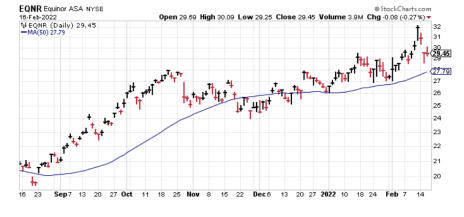I like to keep my finger on the pulse of major trends and position my portfolio accordingly. But one particular headline has me scratching my head lately: pundits are arguing that developing renewable and alternative energy sources is somehow triggering inflation.
Their notion is that the U.S. is emphasizing wind, solar, nuclear and electric vehicles, while canceling fossil fuel projects and hurting U.S. oil production. That in turn is making America produce less oil and gas, raising prices. Since energy is the biggest component of the consumer price index, that supposedly means renewables are driving inflation.
While I like themes, I also like data. So I looked up the oil and gasoline production of the U.S. from the Energy Information Agency (EIA). I compared the first 11 months of 2020, the last year of a fossil-fuel friendly presidential administration, to the first 11 months of 2021, the first of an administration supportive of renewables (December 2021 data has yet to be released by the EIA). The stats show that crude oil production did in fact dip last year: by 1.6%, or 63.2 million barrels, from January through November. To put that in perspective, the country consumes 18 million barrels of oil a day, so that’s a half-week shortfall.
How did that affect the thing we notice most about inflation: prices at the pump? American gasoline production actually increased in 2021, by 8.5%. The country produced 133.4 billion gallons of gasoline last year, compared to 123 billion in 2020. Plus, Americans bought more EVs last year than ever before, up 11% from 2020. That’s demand going away, a decidedly deflationary force. Now clearly there’s something inflationary at work, given the average price of a gallon of gas was $3.10 last year compared to $2.26 in 2020 – but it’s not the strangling of fossil fuels by renewable energy nuts.
Returning to themes, there’s another reason the argument renewables causes inflation doesn’t hold up: Renewables are the cheapest way to produce electricity at scale.
Investment bank Lazard Freres calculates annually the cost of utilities producing electricity. In 2009, solar was the most expensive source of power, at $359 a megawatt hour (MWh), with wind at $135 Mwh. The cheapest source of power that year, at $76 MWh, combined cycle natural gas plants (ones that use waste heat from a primary gas turbine to turn a steam turbine).
Fast forward to 2021: a utility scale solar plan is the cheapest way to generate power, at $36 a MWh, followed by wind at $38. Third place is a natural gas combined cycle, at $60. In fact, solar and wind have been the two cheapest electricity sources since 2015, according to Lazard. Cheaper electricity means cheaper energy. It’s true that adding in energy storage to renewables raises the cost, but so do peaker plants – all those natural gas power plants utilities build to use a few days a year when demand is highest on hot summer days.
Peaker plants are now the most expensive source of electricity, at $173 a MWh, according to the investment bank. That’s why renewable energy capacity in the U.S. grew 39% in the four years of the prior administration, despite its favoring fossil fuels.
The truth is, both fossil fuels and renewables are needed now to meet demand, even as the megatrend toward renewables remains unstoppable. I help Cabot subscribers invest in the megatrend as Chief Analyst of our Sector Xpress Greentech Advisor newsletter.
Equinor Stock: Investing in Both
For those looking to play the near-term price jump in oil and gas with a ticket into the long-term winnings of renewables, I do have one stock to suggest. It’s Equinor (EQNR), the Norwegian state-controlled energy company that used be known as Statoil. Equinor produces oil and natural gas mainly from North Sea oil fields at a low cost: The company makes money when oil is above $25 a barrel. Oil and gas production will probably produce $45 billion in free cash flow over the next five years, assuming $60 a barrel. Make no mistake: It’s one of the largest fossil fuel producers in the world right now.
Equinor also has a large renewable energy portfolio. It operates much of Poland’s offshore wind farms and will participate in the Beacon and Empire wind farms off the coast of Massachusetts and New York. It also is opening up the world’s first carbon sequestration project that will provide sequestration capacity to third parties, using oil and gas technology to pump carbon into subsea fields off the coast of Norway.
By 2030, Equinor expects half its revenue to come from renewables. Equinor stock recently broke through a long-term ceiling of 25 per share and shares are showing excellent relative strength compared to the broad market.
Do you own Equinor stock? Do you own any other renewable energy/energy hybrid type stocks? Tell us about them in the comments below.


